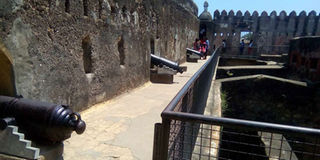Ignored monuments could woo tourists to Kenya, say architects

Fort Jesus. FILE PHOTO | NMG
What you need to know:
- Jomo Kenyatta University of Agriculture and Technology’s Centre for Urban Studies founding director, architect Mugwima Njuguna, senior lecturer Gerryshom Munala and Department of Construction Management lecturer Teckla Muhoro said Nairobi had distinctive buildings that keep alive Kenya’s social, political and cultural history.
- The dons said the current occupiers of such structures should be granted tax incentives, among other financial benefits, to enable them continue preserving them.
- The report precedes last week’s announcement by Sanlam Group that it was disposing of its five-storeyed headquarters on Kenyatta Avenue, Nairobi, which is a preserved monument, for Sh460 million.
- This set tongues wagging as the property is centrally located in the city where a vacant plot similar to the 0.34 acre parcel of land would go for Sh500 million.
Three architectural scholars have urged the government to consider funding restoration of historical buildings across the country.
In a joint paper, they said the country should go beyond prohibition of destruction and allow renovation using public funds.
This was contained in a paper titled, “Reflections on Architectural Morphology in Nairobi, Kenya: Implications for Conservation of the Built Heritage”.
Jomo Kenyatta University of Agriculture and Technology’s Centre for Urban Studies founding director, architect Mugwima Njuguna, senior lecturer Gerryshom Munala and Department of Construction Management lecturer Teckla Muhoro said Nairobi had distinctive buildings that keep alive Kenya’s social, political and cultural history.
“These buildings, in their various styles, paint Nairobi as a cross-cultural city where a range of world architecture has become acceptable. Historic buildings in Nairobi are under significant pressure from property and infrastructure development,” they said.
The dons said the current occupiers of such structures should be granted tax incentives, among other financial benefits, to enable them continue preserving them.
“Governments also provide tax credits for the restoration of commercial buildings listed as monuments. Successful preservation of old towns and buildings might be of use if applied in Nairobi. This will help in ensuring that property owners do not feel short-changed or burdened when their buildings are listed as monuments,” says the paper.
Tourist attractions
The paper, published in the current JSTOR digital library, adds that all documented historical buildings must be publicised as tourist attractions and subjects of study for students of various building technologies.
“Keeping historic buildings in constant and efficient use seems to be the best for their conservation. Sustainable, innovative conservation efforts need to be devised and implemented,” it adds.
The report precedes last week’s announcement by Sanlam Group that it was disposing of its five-storeyed headquarters on Kenyatta Avenue, Nairobi, which is a preserved monument, for Sh460 million.
This set tongues wagging as the property is centrally located in the city where a vacant plot similar to the 0.34 acre parcel of land would go for Sh500 million.
“It is greatly undervalued and its recognition as an 86-year-old preserved monument should have attracted billions of shillings. We need to create value for preserved monuments to help increase interest among property dealers,” said Nairobi resident Peter Mutai.
National Museums of Kenya director general Mzalendo Kibunjia said Kenya needs to urgently rethink its preservation strategy by ordering regular valuations of all monuments in public and private hands to promote interest among property dealers and seekers.
“Heritage conservation is threatened by increased building construction, infrastructural expansion as well as terrorism. Conservators must seek to expand principles and practices in the management of cultural and natural heritage,” he said.
Go to ruin
Interestingly, while Nairobi is awash with marvelous architectural buildings, their preservation is wanting with their current owners deliberately letting them go to ruin as the land they stand on is more valuable when vacant.
An example is Nairobi’s Chiromo Mansion built in 1905 and initially occupied by colonial administrator E.C Grogon.
Its is now owned by the University of Nairobi.
The building needs urgent repairs.
Another property is Surat District Association Building located on Uyoma Street and built in 1943. It is showing signs of neglect.
Most of the preserved buildings are in ruin. They fetch their owners low returns from fees paid by temporary occupiers operating stalls.
According to JKUAT scholars, a holistic approach should be taken where Kenyans in their respective counties are involved in creating a sense of civic pride and ownership that ignites positive involvement in preservation of monuments.
While everyone agrees that historic buildings in Kenya are architectural marvels, no funds have ever been set aside to document them for posterity.
In Morocco, historical buildings are the biggest tourist attraction, bringing in 10.3 million visitors in 2016, compared with Kenya’s 1.2million during the same period.




